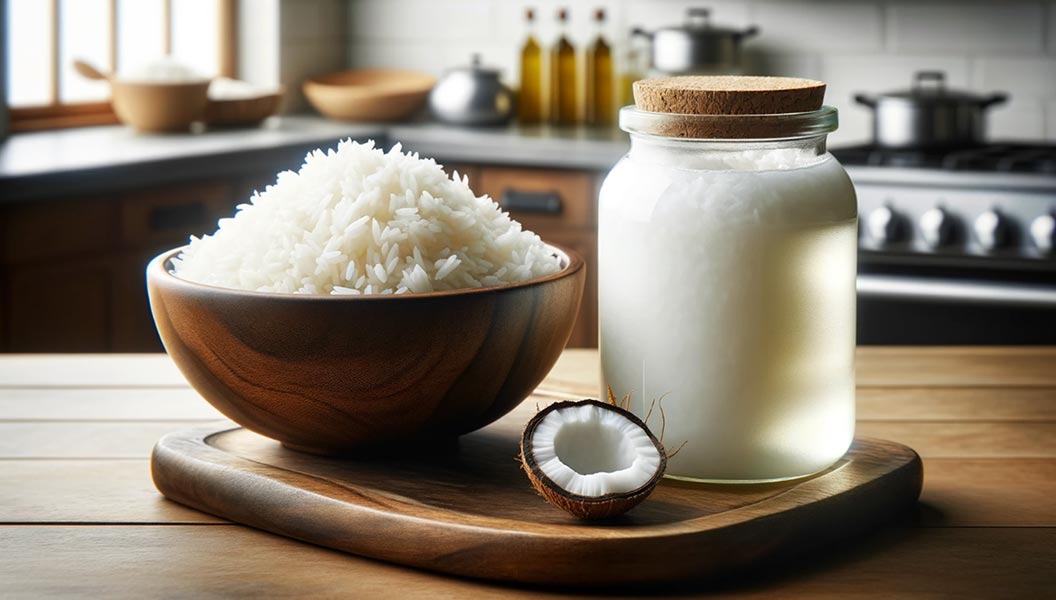Over half the global population relies on rice as a fundamental food source. It is incredibly versatile, complements many dishes, and provides a quick and easy energy source. However, traditional rice can sometimes pose a challenge for those looking to limit their calorie intake or manage their weight due to its high carbohydrate content.
But what if there was a way to enjoy your favorite rice dishes without compromising your health goals? Researchers may have found an ingenious solution to this conundrum - introducing coconut oil-infused rice! So, if you eat rice and are seeking to eat fewer calories, read below.
Why Does Rice May Not Be Healthy?
High Carbohydrate Content
The main component of rice is carbohydrates, which have the potential to cause a swift increase in blood sugar levels. This fact holds particular significance for individuals managing diabetes or seeking to regulate their blood sugar levels.
Lack Of Essential Nutrients
Although rice supplies energy through carbohydrates, it is comparatively deficient in vital nutrients when compared to other whole grains. It lacks significant amounts of vitamins, minerals, and antioxidants found in whole grains like quinoa, oats, or barley. Relying heavily on rice as a staple food without incorporating a variety of nutrient-rich foods may lead to nutrient deficiencies.
High Glycemic Index
White rice, particularly short-grain varieties, exhibits a high glycemic index, resulting in a greater elevation of blood sugar levels compared to low-glycemic foods. This rapid blood sugar spike can potentially lead to insulin resistance, weight gain, and an increased risk of chronic conditions like type 2 diabetes and cardiovascular diseases.
Arsenic Contamination
Rice may contain small quantities of arsenic, which is a naturally existing element present in the soil. The levels of arsenic can vary based on the rice variety, cultivation methods, and geographic location. Long-term exposure to high levels of arsenic in rice has been associated with health risks, such as increased cancer risk and potential harm to neurological development.
Caloric Density
Rice is relatively calorie-dense compared to certain vegetables or other whole grains. Consuming large portions of rice without considering portion sizes and overall calorie intake may lead to weight gain, especially when combined with high-fat and high-sugar ingredients in rice-based dishes.
How Many Calories Are In A Cup Of Rice?
The calorie content of a cup of rice can fluctuate based on the rice variety being used. Here are approximate calorie ranges for different types of cooked rice:
White Rice (Medium-grain, cooked): Approximately 200-240 calories per cup.
Brown Rice (Long-grain, cooked): Approximately 215-220 calories per cup.
Jasmine Rice (Long-grain, cooked): Approximately 180-200 calories per cup.
Basmati Rice (Long-grain, cooked): Approximately 190-210 calories per cup.
Wild Rice (Cooked): Approximately 165-175 calories per cup.
How Does Rice With Coconut Oil Help Reduce Calories?
In a study presented at the American Chemical Society, Sri Lankan researchers discovered that adding coconut oil to rice and then cooling it can significantly reduce its calorie content. This simple method reduces calories in rice by up to 60%, making your meals healthier and friendlier to your waistline.
The science behind this lies in the nature of the starch in rice. Rice consists of two types of starch: digestible starch and resistant starch. Digestible starches are rapidly converted into glucose, which can be stored as fat if not utilized. On the other hand, resistant starches take more time for the body to digest and process. Humans lack the necessary enzymes to digest resistant starch effectively, resulting in its slower breakdown and limited conversion into sugar. As a result, resistant starch is not readily absorbed into the bloodstream like digestible starch, which can lead to a slower and more gradual release of glucose into the bloodstream.
Coconut oil is rich in medium-chain triglycerides (MCTs), which undergo a distinct metabolic process compared to the long-chain triglycerides found in other oils. When you add coconut oil and rice together, the oil interacts with the starch molecules, altering their architecture and transforming them into resistant starches. Cooling the rice further enhances this process. MCTs are quickly absorbed and used as an energy source, potentially leading to slightly increased calorie burning. Nevertheless, it is crucial to acknowledge that the reduced calorie intake resulting from using coconut oil in rice is relatively modest.

How to cook rice with coconut oil
Ingredients
1 cup of white rice
2 cups of water
1 tablespoon of virgin, unrefined coconut oil
Instructions
- Soak the rice for at least 30 minutes to one hour. This step is optional.
- Thoroughly rinse the rice with cold water until the water runs clear.
- Heat the water in a pot or medium saucepan until it reaches boiling. Add both the coconut oil and rice to the boiling water and proceed with the regular cooking process. You can also use a rice cooker if it's available
- Once the rice is cooked, allowing it to cool in the refrigerator for approximately 12 hours is important. This step should not be omitted, as cooling is vital for transforming the rice's starches.
- After the cooling period, the rice is ready to be reheated and served.
Why You May Want To Soak The Rice Before Cooking
Soaking rice before cooking can help reduce the starch content of the rice to some extent. When you soak rice, it allows water to penetrate the grains and begins the process of leaching out some of the starch. As a result, the starch content of the soaked rice may be slightly lower than rice that hasn't been soaked.
Soaking rice for a longer duration, such as several hours or overnight, can further enhance the reduction of starch content. Additionally, some individuals opt to rinse the soaked rice before cooking to eliminate any surplus starch.
Reducing the starch content in rice through soaking can result in slightly firmer and less sticky cooked rice. This may be preferable for certain dishes or personal preferences. However, it's important to note that soaking rice will not eliminate all the starch, as rice naturally contains a significant amount of carbohydrates in the form of starch.
How Letting The Rice Cool Can Help To Transform The Rice's Starches
Allowing rice to cool after cooking can lead to the transformation of starches in the rice. When rice is cooked, the starch molecules undergo gelatinization, absorbing water and becoming more easily digestible.
However, as the cooked rice cools, some of the starches undergo a process called retrogradation. Retrogradation is the reformation of the starch molecules into a more ordered structure. During retrogradation, the starches become less accessible for digestion by the body.
This transformation into a more resistant form of starch is what gives cooled rice a higher content of resistant starch. Resistant starch functions as a form of dietary fiber, moving through the small intestine without undergoing complete digestion and absorption. Instead, it reaches the large intestine, which can benefit gut health and offer less available energy to the body.
The cooling process of rice does not directly reduce the overall calorie content of the rice. Instead, it alters the digestibility of the starches, potentially affecting how the body processes and utilizes the energy from the rice.
It's worth noting that the degree of retrogradation and the amount of resistant starch formed can vary based on factors such as the type of rice, cooking method, and cooling conditions. Additionally, reheating the cooled rice can partially reverse the retrogradation process, reducing the amount of resistant starch present.

FAQs
Can Coconut Oil Be Used With Any Type Of Rice?
Yes, coconut oil can be used with any type of rice, whether it's white rice, brown rice, jasmine rice, or basmati rice.
How Much Coconut Oil Should I Use To Reduce Rice Calories?
To reduce rice calories, it's recommended to replace a portion of the cooking oil or butter with coconut oil. Use about 1 teaspoon for every half a cup of uncooked rice.
Does Coconut Oil Change The Taste Of Rice?
Coconut oil can add a subtle coconut flavor to the rice, elevating its flavor profile. If you don't like the flavor of coconut, refined coconut oil will have less flavor than unrefined.
Are There Any Health Benefits Of Using Coconut Oil In Rice?
Coconut oil contains MCTs, which may provide a quick energy source and potentially benefit weight management. Furthermore, coconut oil possesses antimicrobial and anti-inflammatory properties. Nevertheless, consuming coconut oil in moderation is crucial due to its elevated saturated fat content.
Can I Use Coconut Oil To Reduce The Calorie Content Outside Of Rice Grains Or Carbohydrates?
Coconut oil can be used as a substitute for other cooking oils in various dishes, including grains and carbohydrates, to reduce the overall calorie content potentially. However, reducing calories is relatively small, so it's important to focus on overall portion control and a balanced diet.
Will Using Coconut Oil Affect The Texture Of The Rice?
Using coconut oil in rice preparation is unlikely to affect the texture of the cooked rice significantly. It should remain similar to how it would turn out when cooked with other oils or fats.
Are There Any Potential Risks Or Drawbacks To Using Coconut Oil In Rice?
Due to its high saturated fat content, consuming coconut oil in moderation is advisable. While it may have potential benefits, excessive consumption of saturated fats can contribute to elevated cholesterol levels and increased risk of heart disease. It is essential to consider your overall dietary fat intake and make informed decisions. Seeking personalized guidance from a healthcare professional or nutritionist can be valuable in this regard.
Can Coconut Milk Reduce Rice Calories?
You can use full-fat coconut milk to make a coconut rice recipe, but using coconut milk instead of coconut oil does not directly reduce the calorie content of rice. Coconut milk is higher in calories than coconut oil because it contains both the oil and the coconut meat.
Coconut oil is pure fat, which is a concentrated source of calories. When you substitute coconut oil with coconut milk, you add more calories to the rice dish rather than reducing them.
To reduce the calorie content of rice, you may consider using alternative cooking methods or lower-calorie ingredients, such as using less oil or fat during cooking, opting for smaller portions, or exploring lower-calorie rice alternatives like cauliflower rice. It's important to be mindful of portion sizes and overall calorie intake when reducing the calories in rice or any other dish.
Conclusion
Adapting this method into your routine is a relatively easy and efficient way to reduce calorie intake while still enjoying your favorite rice-based dishes. This process not only reduces the number of calories absorbed but also increases your intake of 'good' resistant starch, promoting digestive health.
Remember, this method won't make rice calorie-free but can make it healthier. As with any dietary changes, eating balanced meals, exercising regularly, and consulting a dietitian or nutritionist to discuss your specific dietary needs and goals is essential.
The world of nutrition science is always full of fascinating discoveries like this one, allowing us to enjoy the foods we love while also caring for our health. Happy cooking, and enjoy your healthier, coconut oil-infused rice!
